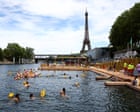
This week brings a tapestry of stories from across the world, each highlighting a profound connection to water—whether it’s through celebrating a significant environmental achievement in Paris or navigating the challenging aftermath of natural phenomena in Texas. These narratives invite us to reflect on our relationship with the natural world and underscore the resilience and resourcefulness inherent in communities facing both celebration and adversity.
In a heartwarming development for Paris, the River Seine has been officially reopened for public swimming after a ban that spanned over a century. This decision marks the culmination of a significant €1.4 billion clean-up initiative, a transformative effort enhanced by the river’s renewed role in the Paris Olympics of the previous year. This massive undertaking was largely driven by local advocates who, for years, had passionately campaigned for the Seine’s restoration. This weekend, Parisians and tourists alike joyfully embraced the opportunity to reconnect with the river, as about 1,000 visitors were welcomed daily to swim across three beautifully curated bathing sites. The reopening of the Seine reflects a milestone in urban environmental restoration, signaling a broader commitment to integrating nature into urban living while enhancing public recreation.
In contrast, Texas faces a somber and challenging situation as it deals with the aftermath of severe flooding. Over the past week, intense downpours have caused the Guadalupe River to swell by more than 20 feet in less than two hours, tragically resulting in the loss of approximately 78 lives and leaving several individuals missing. Among the hardest hit are the families and friends of ten girls from Camp Mystic, a Christian youth camp that bore the brunt of the deluge. President Trump has responded by declaring a major disaster, which directs Federal aid to assist with recovery efforts and support the affected communities.
This devastating event underscores the vulnerabilities faced by regions like Texas’s ‘flash flood alley,’ where the frequency and severity of extreme weather events are being magnified by the ongoing climate crisis. As rescue operations continue, authorities report that water levels in some affected areas have begun to recede, offering a glimmer of hope amid the devastation. Hundreds of rescue workers are diligently searching for those still missing while providing assistance to residents gradually returning to their homes to assess the damage.
The unpredictable nature of recent weather patterns highlights the complexities of forecasting in the context of a warming climate. While the reality of these challenges is confronting, it also illuminates areas where innovation and adaptation could pave the way for more resilient communities. Efforts to improve emergency response strategies are already underway, focusing on enhancing the predictive tools available to better prepare for and mitigate future disasters.
As these two narratives unfold, they provide a poignant reminder of the power and unpredictability of nature. They also offer insight into the resilience and determination that characterize the human spirit—whether it’s in the joy of reclaiming a beloved urban river or through the collective resolve to recover and rebuild in the aftermath of a natural disaster.
Globally, each of these stories prompts us to reconsider our relationship with the natural world and our role in shaping a sustainable future. As cities like Paris manifest visions of environmental renewal and regions like Texas band together to face the future’s uncertainties, both highlight the enduring connection humanity shares with its environment. These stories are not just about the immediacy of events; they are about enduring commitments to fostering a world where nature and communities thrive harmoniously.
Source: {link}
